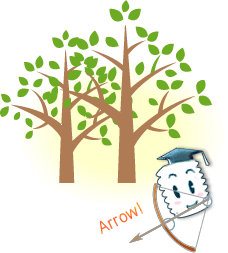
Episode 25: Gratitude for “Trees” Springs
Hello everyone.
It’s been a long time since my last update. I’ve been extremely busy lately with all of our efforts after the terrible events of the earthquake, tsunami and nuclear accident in March. We’re now able to see some light at the end of the tunnel in our supply of springs to the automobile industry, which is our biggest area of demand. Finally, we are returning to a normal production schedule like that of before those terrible events.
We will more speedily supply the high-quality products we are known for in the future. We hope all of our customers will continue to support us in our efforts to meet that goal.
The summer was unbelievably hot this year! Despite the summer heat, I can see that the trees and grasses are telling us that fall will soon be here. Almost all of the leaves on the Sakura have dried and fallen; the leaves that were thick on the camphor tree have all changed colors.
Do you know that the Japanese people have used wood in springs from ancient times?
One example is the “bow”. The bow is one of the oldest forms of a spring in the world.
In fact, from the Jomon period in Japan, bows were already in use, though they were slightly shorter in those days. The bow changed dramatically in the Yayoi period to become the length it is today, because of the influence of southeast Asian cultures. The bow in those days was made from the branches of a variety of trees. Some were manufactured by whittling, but they almost always used the materials as they are.
However, when Japan entered the Heian period, there must have been some reason to begin using bamboo. Bows were made by sandwiching both sides of the wood with bamboo.

Human ingenuity and imagination are really something to admire. They also began to develop a need for something even better. Pascal, the French philosopher, mathematician and physicist (so many titles!) once said: Man is a thinking reed. The quote describes that man is above nature simply because he is a thinker. The reed described here is the same kind of thin material used when you play the saxophone or clarinet.
Why did Pascal use such an expression to compare mankind and reeds? It is said that he described it this way: Man is a reed, the weakest of nature, but it is a thinking reed.It is not necessary that the entire universe arm itself to crush: A vapor, a drop of water suffices to kill him. I personally don’t think that a reed is so weak. They are actually quite firm, and grown quite tough to live in marshes.
I’m sorry. I’m digressing.

At any rate, in the Nara period, chopsticks were formed by bending bamboo into a U-shape. They were shaped something like tweezers or tongs. Tongs are an unusual term for a metal tool you may see your mother or father using to handle hot charcoal on the grill or firewood. You can see them at some “yakiniku” style restaurants in Japan to handle meat as it is being cooked, but these are three or four times larger.
Do you know that these kinds of bamboo chopsticks, called “hashi” in Japan, are still in use for important rites conducted by the Japanese imperial family?
We also have U-shaped scissors in use in Japan too. When I was a small child, they used to use a large U-shaped scissors to sheer wool from sheep. Later the sheers were manual, and then later they became electrified.
Anyway, this time, my discussion digressed a bit, but I just wanted to tell you how wood can also be a very good type of natural spring.
This is as far as I can go this time.
Despite the change in seasons, I always look forward to “spring”. I also look forward to hot “springs” in winter.
See you next time!
Written by Banekko (a child of spring)

